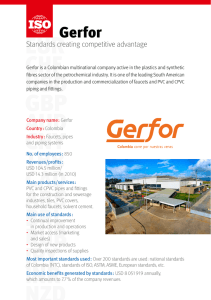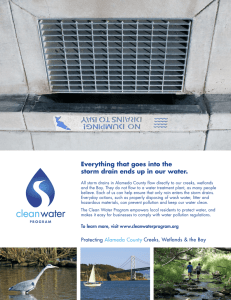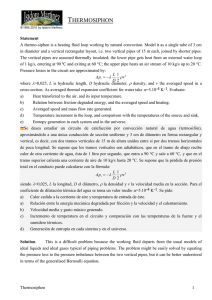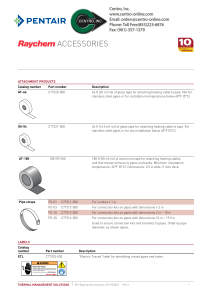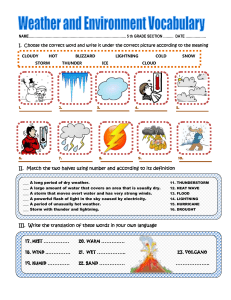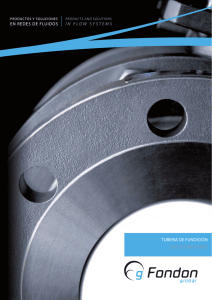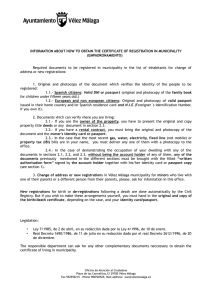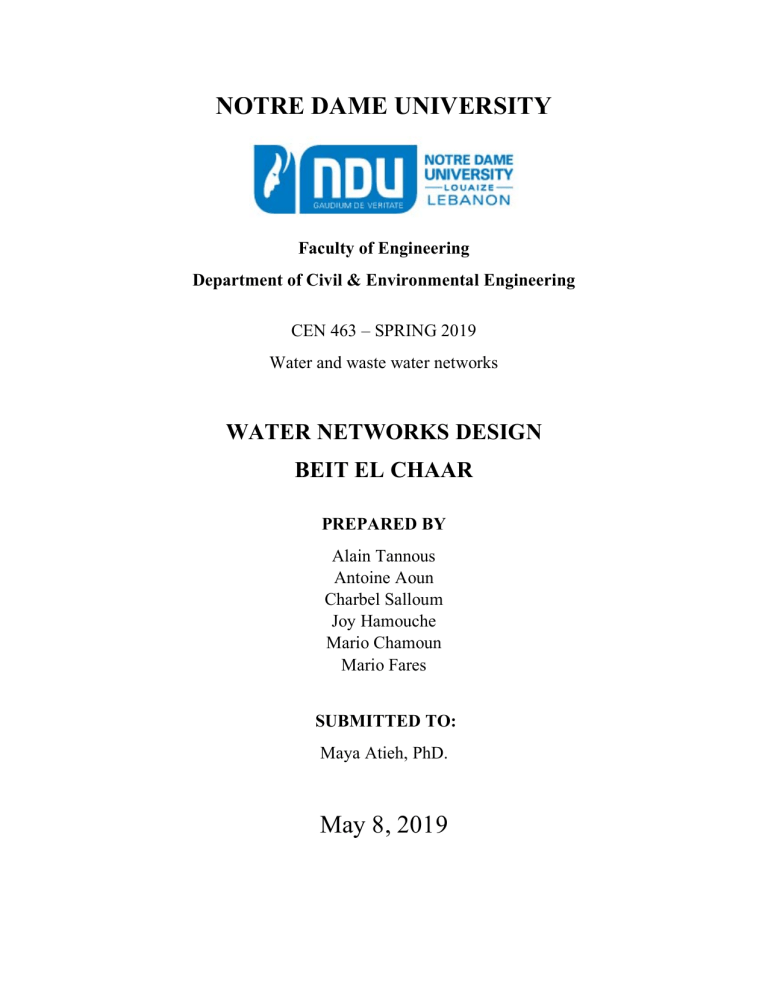
NOTRE DAME UNIVERSITY Faculty of Engineering Department of Civil & Environmental Engineering CEN 463 – SPRING 2019 Water and waste water networks WATER NETWORKS DESIGN BEIT EL CHAAR PREPARED BY Alain Tannous Antoine Aoun Charbel Salloum Joy Hamouche Mario Chamoun Mario Fares SUBMITTED TO: Maya Atieh, PhD. May 8, 2019 1. Abstract In the water and waste water network course, it was required to choose a Lebanese city and design its water distribution network, storm water system and wastewater network. Beit el Chaar was picked and the study began. The municipality was visited, the necessary data was collected and the design phase started. First, the population was projected to 50 years ahead to design accordingly, then, the demand of the city was calculated to be 7207500 L/day. Then, a storage tank was designed to satisfy the need of the city. After that, EPAnet was used to design the water distribution network. The map was divided into 6 loops that cover the demand of the whole city, and the software resulted in the diameters of the pipes, flows and velocities in the links and pressures at the nodes. The results were overall satisfactory although some problems were faced in keeping the pressures within the limits. After that, a storm network was designed by hand calculation using the Rational method taking into consideration the peak runoff that can occur. Then, similarly, a waste water network was also designed by hand calculations making sure that the diameters of the pipes are within the allowed limits, as well as the velocities in the pipes. Finally, a brief non-professional cost estimate was provided to have an idea about the project cost as a whole. 2 Contents 1. Abstract ............................................................................................................................... 2 2. Introduction ......................................................................................................................... 5 3. Location .............................................................................................................................. 7 3.1 Geography, topography and climate .............................................................................. 7 3.2 Land use, zones and areas. ............................................................................................ 8 4. Population growth and projection......................................................................................... 9 5. Water demand and fire requirements .................................................................................. 11 6. Design flow ....................................................................................................................... 12 7. Water storage tank design .................................................................................................. 14 8. Water distribution network................................................................................................. 17 9. Design of water distribution network using EPAnet ........................................................... 18 10. Storm Water System....................................................................................................... 21 11. Waste Water System ...................................................................................................... 25 12. Cost estimate .................................................................................................................. 29 13. Conclusion ..................................................................................................................... 30 14. References...................................................................................................................... 31 List of Tables Table 1. Zones and surface areas ................................................................................................. 8 Table 2. Population data in Beit el Chaar .................................................................................... 9 Table 3. Distribution of population in Beit el Chaar .................................................................. 10 Table 4. Water demands for each zone ...................................................................................... 11 Table 5.Variation of water demand throughout the day ............................................................. 13 Table 6. Operational and equalizing storage results ................................................................... 15 Table 7. Drainage areas and properties ...................................................................................... 23 Table 8. Computation of slopes ................................................................................................. 23 Table 9. Maximum and minimum factors for average daily flow ............................................... 26 Table 10. Distribution of Q to the manholes and calculation of slopes, diameters and velocities 27 Table 11. Check for minimum factor for average daily flow...................................................... 28 Table 12. Cost estimate ............................................................................................................. 29 3 List of Figures Figure 1. Location of Beit El Chaar on the Lebanese map ........................................................... 7 Figure 2. Distribution of zones in Beit el Chaar ........................................................................... 8 Figure 3. Variation of population per year ................................................................................... 9 Figure 4. Hourly demand as percent of average ......................................................................... 13 Figure 5. Variation of hourly supply and demand versus time ................................................... 16 Figure 6. Galvanized steel pipes ................................................................................................ 18 Figure 7. EPAnet Pipe Network Layout .................................................................................... 19 Figure 8. EPAnet results: velocity in pipes and pressure at nodes .............................................. 19 Figure 9. EPAnet Table indicating the Velocity and Flow Results in the pipes .......................... 20 Figure 10. EPAnet Table indicating the Pressure and Head Results at the junctions .................. 20 Figure 11. Drainage areas and storm water manholes ................................................................ 21 Figure 12. Rainfall intensity vs duration.................................................................................... 22 Figure 13. Location of manholes throughout the main street ..................................................... 25 4 2. Introduction When someone says water networks, this means that water distribution network, stormwater drainage system and waste water system are being referred to. First, a definition of each will be stated to clarify the aim of this study. • A water distribution network is also known as a water supply system, which provides people with the necessary quality amount of water, to be used for many purposes and satisfy their basic needs. • A stormwater drainage system is a system that tends to maneuver and manage the water runoff that occurs due to excess of rainfall. • A waste water system is a system that is responsible for collecting and disposing of water that goes down the sinks, toilets and drains. In Lebanon, water networks are poorly designed in many areas especially in rural ones that are away from the cities, and if present, they lack maintenance and sometimes need replacement. People are recently suffering from water shortage crisis although rainfall is attaining its yearly averages. The main reason behind that is our damaged and poorly designed networks that lead to water leakage, or that fail to provide the needed amount of water. Our responsibilities as engineers is to contribute as much as possible in solving this water network problem, even if it is a small contribution. Hence, a project was provided in the waste and waste water networks course that required to pick a local municipality, collect the needed data, make logical assumptions if the data is absent, and then design a water distribution system, a stormwater system and a wastewater system for the chosen municipality. The design will be performed by hand calculations and using the EPAnet software. First, a local municipality will be chosen, visited and studied. Data about its area, topography, soil types, climate, land use (residential, commercial, industrial…), population and water usage will be collected. Then, the population will be projected to 50 years in order to design accordingly. The water demand will then be calculated, taking into account the water fire demands. After that, the variation of this demand across the year, and throughout the day and hours will be checked. 5 Second, water resources (inlets) and the location of outlets on the map will be identified. Thus, the map will be divided into loops to make sure that the nodes are located at the inlets and outlets, and that all the areas of the city are covered and can benefit from the water distribution system. EPAnet software will be used to draw the loops and run the analysis accordingly. The outcome of the software will result in the flow in each pipe, the diameter of the pipes, velocities, heads and pressures. In addition, a water storage tank will be designed in order to provide the necessary operational and equalizing volume to satisfy the needs of the city. Its location will be decided on throughout the report. Then, a stormwater drainage system will be designed to cover a part of the studied area. The rational method will be used and hence the diameters of the storm network pipes will be calculated by hand. Once done, a wastewater system will also be designed by hand calculations to come up with a diameter and a velocity of the flow. At the end, a brief cost analysis will be provided based on research only (no experience in this field), in order to have an idea how much this project will cost as a whole. 6 3. Location 3.1 Geography, topography and climate Beit El Chaar - Mazraat El Hdaira is a Lebanese village situated in Matn - Mount Lebanon. The municipality is a member of Federation of “Matn El Chamali El Sahili Wal Awsat” municipalities. It is located a little north east of Beirut’s airport (17 km away). It is surrounded by Dik El Mehdi from the north, Mazraat Yachou’ from the east, Mtaileb from the South and Mazraat El Hdaira from the west. This municipality’s altitude ranges between 210 m above sea level at the extreme west and 400 m at the extreme east. It has a mountainous topography similar to all the areas that are located on the west side of Mount Lebanon. Figure 1. Location of Beit El Chaar on the Lebanese map The average temperature in Beit El Chaar is moderate, varying between 9°C in winters and 28°C in summers, in average. 7 3.2 Land use, zones and areas. Beit El Chaar is mostly a residential area, with a public park that occupies around 1.5% of the total municipality area. Although there are some small commercial shops on the ground floor of some buildings along the main roads, they can be assumed as residential apartments because they are mostly family size companies (2 to 3 persons at most). Hence, what is important is that Beit El Chaar does not include any schools, universities, hospitals, sports academies or industrial areas of any kind. The total area of Beit el Chaar covers around 0.63 km2 in surface, divided into 5 main zones, whose data was collected from the municipality. These zones vary in size, shapes and elevations, but they are all residential areas in general, and are detailed in table 1 and illustrated in figure 2. The sum of all the areas in table 1 results in a total of 628580 m2, equivalent to 0.62858 km2. Table 1. Zones and surface areas Zone Surface area (m2) A 68093 A1 62251 B 414705 B1 47358 B2 36173 Figure 2. Distribution of zones in Beit el Chaar 8 4. Population growth and projection Population statistics in Beit el Chaar were last taken in 2015, and no accurate number is recent. The population was projected 50 years starting 2015, which is the year when the last data was collected. The population growth between 1995 and 2015, detailed in table 2, was provided by the municipality. Table 2. Population data in Beit el Chaar Year Population 1995 4500 2000 5300 2005 5600 2010 6600 2015 7500 8000 7500 y = 146x - 286830 R² = 0.976 Population 7000 6500 6000 Actual growth 5500 Linear growth 5000 4500 4000 1990 1995 2000 2005 2010 2015 Year Figure 3. Variation of population per year 9 2020 Plotting the population versus the year, it is shown in figure 3 that a linear trendline is the best fit line that suits this population growth, because the R-squared value is close enough to 1. Hence, an arithmetic growth will be taken into consideration to estimate that population 50 years from 2015, in 2065. From figure 3, the slope of the best fit line was obtained to be 146, which is karith. So, to estimate the population at the 50th postcensal year (2065), the following calculation was done: 𝑦" = 𝑦$ + &𝑡" − 𝑡$ )𝑘+,-./ 𝑘+,-./ = slope of linear trendline = 146 𝑦0123 = 7500 + (2065 – 2015)×146 = 14800 persons. These people are distributed randomly in Beit el Chaar and no precise data is available regarding the distribution of population. Hence, the population will be distributed according to the percentage of area covered by each zone. Table 3 indicates the distribution of people in Beit el Chaar by the year 2065. Table 3. Distribution of population in Beit el Chaar Zone Surface area (m2) Portion of area (%) Population A 68093 10.83% 1603 A1 62251 9.90% 1466 B 414705 65.97% 9764 B1 47358 7.53% 1115 B2 36173 5.75% 852 Total 628580 100% 14800 A sample calculation is detailed below: For zone A, the percent of area covered by zone A is: 68093 628580 Population in zone A: 14800 × 0.1083 = 1603 persons 10 = 0.1083 = 10.83% 5. Water demand and fire requirements No accurate data is available regarding the average residential water demands in Beit el Chaar, so it was assumed that each person consumes 160 liters per day. Plus, as mentioned before, in zone B, there is around 1.5% of the total area of the municipality covered by a public garden, which is around 9500 m2. It is known that gardens need at least 1 inch of water per week, which is equivalent to around 0.623 gallons per week for each square foot. Water needed for the 9500 m2 garden: 9500 m2 = 102257.1 ft2 0.623 gal × 102257.1 ft2 = 63706 gallons for the total area per week. 63706 gal/week × 3.78541 L/gal = 241153 L/week 241153 L/week × < >??@ A B+CD = 34500 L/d Table 4 will represent the amount of water demands for each zone, assuming that the average residential water demand is 160 Lpcd. Table 4. Water demands for each zone Zone Population Average water demand (L/d) Demand per zone (L/d) A 1603 160 256521 A1 1466 160 234513 B 9764 160 1562286 34500 34500 Garden B1 1115 160 178408 B2 852 160 136272 Total 14800 2402500 11 Fire requirements: The collected information stated that there are around 340 buildings in Beit el Chaar, majority reinforced concrete. However, it is not possible to design for a fire that attacks all the city. This is why 12 buildings will be considered, 2 stories each, with an area of 400 m2 per floor. Total area = 12 × 2 × 400 = 9600 m2 = 103333.5 ft2 Referring to Table 4.13 in the textbook named Water Supply and Wastewater Removal, 3rd ed, and having an area between 97701 ft2 and 112700 ft2, the required fire flow for type I noncombustible buildings is 3500 gpm for 3 hours. This is equivalent to: E+F H "-G 3500 "-G × 3.78541 E+F × 60 /IJ, × 3 hours = 2385000 L 6. Design flow v Considering peak daily demands: Qpeak daily = kQavg + Qfire = 1.8×2402500 + 2385000 = 6709500 L/d v Considering peak hourly demand: Qpeak hourly = kQavg = 3×2402500 = 7207500 L/d Since the peak hourly demand is greater than the peak daily demand that includes the fire requirements, Qdemand = 7207500 L/d will be considered when designing. Qdemand = A01A311 0K = 300312.5 L/h In order to account for the variation of water demand throughout the day, logical assumptions have to be made. That is why it will be referred to table 6.13 in the same textbook, which provides a real-life situation example where the demands in the morning and at night are maximum, and minimum after midnight. This example provides the hourly demands as percent of the average, for each hour of the day. These values are provided in table 5 and will be used in the design. In addition, a graph shown in figure 4 illustrates the variation pf this percentage throughout the day. 12 Table 5.Variation of water demand throughout the day Time Hourly demand as percent of average (%) Time Hourly demand as percent of average (%) 12 am - 1 1-2 2-3 3- 4 4-5 5-6 6 -7 7-8 8-9 9 - 10 10 - 11 11 - 12 pm 47.9 45.4 44.1 42.1 41.3 42.4 43.2 76.2 108.9 117.8 123.6 126.7 12 pm - 1 1-2 2-3 3- 4 4-5 5-6 6 -7 7-8 8-9 9 - 10 10 - 11 11 - 12 am 132.4 135.2 133.4 132.4 133 139.5 153.3 195.5 174.4 105.8 53.8 51.7 250 Percent of average demand (%) 200 Actual demand Average demand 150 100 50 0 12:00 AM 4:00 AM 8:00 AM 12:00 PM 4:00 PM 8:00 PM Time Figure 4. Hourly demand as percent of average 13 12:00 AM 7. Water storage tank design We are all aware that there are significant variations in water demands at different time periods of the day. The equalizing and operating storage, which is the quantity of water required to meet the peak demands in a community, will depend on these variations. Thus, in order to design the volume of a water storage tank, the average demand of 300312.5 L/h will be used, and depending on the hourly demand as percent of average, it will be known how much water should be provided hourly. However, the supply on the other hand should also be considered. In the design, it will be assumed that a continuous pumping into the storage tank throughout the 24 hours of the day is provided, in a way that the total supply equals the total demand of 7207500 L/d. Note that the numerical or tabular method will be used to calculate the operational and equalizing storage, As calculated before, the total volume of 7207500 L/d accounts for the fire requirements. However, in case the inflow to the reservoir is shut off due to equipment failure, pipeline breaks, power failure, pumping failure, contamination or due to maintenance, an emergency reserve storage, that sustains the community needs in case any of these problems takes place, should be considered. This emergency storage is generally not more than 25% of the total storage. Considering an unknown dead storage to be used as well, the 25% of the total storage will roughly be equivalent to 30% of the equalizing and operational storage. Thus, the storage tank will be designed accordingly. A sample calculation of the results detailed in table 6 is explained below: Qdaily demand = 7207500 L/d Qhourly demand = A01A311 0K = 300312.5 L/h = Hourly supply (continuous) At 2 a.m., the demand consists of 44.1% of the average demand (300312.5 L/h) Q2-3 = 300312.5 × 0.441 = 132438 L/h The total operational and equalizing storage will be equal to the summation of all positive “supply – demand” or all negative “supply – demand” 14 Table 6. Operational and equalizing storage results Time Hourly demand as percent of average Hourly demand (L/h) Hourly Supply (L/h) Supply - demand (L/h) 12 am - 1 1-2 2-3 3- 4 4-5 5-6 6-7 7-8 8-9 9 - 10 10 - 11 11 - 12 pm 12 pm - 1 1-2 2-3 3- 4 4-5 5-6 6-7 7-8 8-9 9 - 10 10 - 11 11 - 12 am 47.9 45.4 44.1 42.1 41.3 42.4 43.2 76.2 108.9 117.8 123.6 126.7 132.4 135.2 133.4 132.4 133 139.5 153.3 195.5 174.4 105.8 53.8 51.7 143850 136342 132438 126432 124029 127333 129735 228838 327040 353768 371186 380496 397614 406023 400617 397614 399416 418936 460379 587111 523745 317731 161568 155262 300312.5 300312.5 300312.5 300312.5 300312.5 300312.5 300312.5 300312.5 300312.5 300312.5 300312.5 300312.5 300312.5 300312.5 300312.5 300312.5 300312.5 300312.5 300312.5 300312.5 300312.5 300312.5 300312.5 300312.5 156463 163971 167875 173881 176283 172980 170578 71474 -26728 -53456 -70874 -80183 -97301 -105710 -100304 -97301 -99103 -118623 -160067 -286798 -223433 -17418 138744 145051 Total 7207500 Summation of positive values 1537300 Summation of negative values -1537300 Equalizing and operational storage = 1537300 L 15 Figure 5 illustrates the variation of the hourly demand versus the provided hourly supply. The graph looks exactly like the one in figure 4 simply because the 100% of the average demand is equal to the continuous provided supply. By looking at these graphs, it is noticed that the tank is emptying between 8 a.m. and 9 p.m., when the demand is greater than the supply, and filling between 9 p.m. and 8 a.m. when the demand is less than the supply. 700000 Flow rate (L/h) 600000 500000 Hourly demand 400000 Continuous supply 300000 200000 100000 0 12:00 AM 4:00 AM 8:00 AM 12:00 PM 4:00 PM 8:00 PM 12:00 AM Time Figure 5. Variation of hourly supply and demand versus time As discussed before, the emergency reserve storage will be assumed to be 30% of the equalizing and operational storage: Emergency storage = 1537300 × 0.3 = 461200 L Hence, the total volume of the storage tank will be: 1,537,300 + 461,200 + a dead storage assumed to be 500,000 L = 2498300 L 16 8. Water distribution network Requirements: • Satisfied quality and quantity standards • To enable reliable operation during irregular situations (fires…) • To be economically and financially viable, ensuring income for operation, maintenance and extension. • To be flexible with respect to the future extensions. Water sources: Beit El Chaar has no internal source of water. Water is supplied from two springs located in the nearest village of Mazraat Yachouh which are Nabeh El Manboukh and Nabeh El Aasal. But, due to lack of data availability, the supplied flow rates are not recorded to be able to compare them to the demand flow rates. Hence, the supply flow rates will not be included in the design and it will be assumed that enough water is provided to account for the maximum demands. Water Reservoirs: There are no available water tanks in Beit El Chaar, this is why a reservoir tank was designed in the previous section, to be built directly outside the border of the city, in cooperation with Mazraat Yachouh municipality, to take advantage of the highest possible elevation (450 m). Pipes: Galvanized steel pipes are pipes that have been dipped in a protective zinc coating to prevent corrosion and rust. Galvanized piping was commonly installed in homes built before 1960. When it was invented, galvanized pipe was an alternative to lead pipe for water supply lines. Most galvanized steel pipes remain functional for about 40 to 50 years. Galvanized steel pipes are more flame resistant than PVC and are stronger than aluminum. So galvanized steel pipes will be used in the project since it satisfies all the requirements. 17 Figure 6. Galvanized steel pipes 9. Design of water distribution network using EPAnet EPAnet Definition and usage: EPAnet is a computer program that performs extended period simulation of hydraulic and water quality behavior within pressurized pipe networks. A network can consist of pipes, junctions, pumps, storage tanks and reservoirs. Advantages: • Survey data can be read into program (using excel) • All Calculations are done internally and quickly • Summary outputs tables and graphs • Unlimited network size and complexity (Looped systems…) • Error Checking 18 Figure 7. EPAnet Pipe Network Layout Figure 8. EPAnet results: velocity in pipes and pressure at nodes 19 Figure 9. EPAnet Table indicating the Velocity and Flow Results in the pipes Figure 10. EPAnet Table indicating the Pressure and Head Results at the junctions 20 Discussion of Results: Six loops were designed to provide the necessary water for Beit el Chaar. The velocity in the pipes must range between 0.6 m/s and 1.8 m/s. Pressure in pipes must range between 40 to 60 psi and 90 to 110 psi. However, velocities are maintained between the given ranges while pressure is not as shown in figures 8 and 9. To solve this issue, there are two ways to decrease the pressure at the nodes: • Decrease the amount of water flow, which cannot happen because we need to satisfy people’s demands, and this demand cannot be reduced further. • Increase the diameter of the pipes. However, this increase will cause the velocity to drop below the limits and might cause deposition of silt in the pipes. 10. Storm Water System In order to design the draining system for the storm water, the lower half of the area of Beit el Chaar will be considered as shown in figure 11. This area will be divided into 4 smaller ones and each one will lead to a manhole. Figure 11. Drainage areas and storm water manholes 21 In order to use the rational method, some parameters need to be determined 1. A Runoff coefficient of C=0.5 will be used for all areas as stated in the City of Lebanon Specifications for Storm Water Drainage and Retention. 2. The rainfall intensity will be determined from figure 12 that represents a variation of the intensity in function of the storm duration in Beirut. The last 5 years recorded will be considered and assuming a 15 min duration (duration of storm is equal to concentration time) → i = 0.08m/h The 15 minutes duration was assumed based on the longest road that should be traveled by the water to reach the manhole. Assuming an average water speed of 0.5 m/s and having the longest distance to be 450 m, the time is calculated to be 15 min. 3. The areas are computed and tabulated in table 7 Figure 12. Rainfall intensity vs duration 22 Table 7. Drainage areas and properties Drainage Area Area (m2) Cumulative Area (m2) C factor A1 A2 A3 A4 20317 85953 102935 86202 20317 106270 209205 295407 0.5 0.5 0.5 0.5 Table 8. Computation of slopes Manholes Elevations (m) Difference in elevations Distance to previous MH (m) Slope MH1 MH2 MH3 MH4 310 298 285 262 12 13 23 391 382 380 0.031 0.034 0.061 Calculations to compute the diameter for pipe 1 from MH1 to MH2: For tc = 15 min, the rainfall intensity i is 0.08 m/hr C = 0.5 and A = 20317 m2 Qp = kCiA è Qp= 0.5 x 0.08 x 20317 = 812.68 m3/hr = 0.226 m3/s Qp = 1.M<&NO.PQ )&R S.T ) G = 1.M<&NO.PQ)&1.1M<S.T ) 1.1<M è d = 335 mm Take d = 350 mm Qfull = U VWXYY 1.M<&NO.PQ)&R S.T) G = 1.002 1.033 = = 0.89 è 1.M<&1.M3O.PQ)&1.1M<S.T ) 1.1<M Z [WXYY è Qfull = 0.255 mm = 1.02 VWXYY 1.033 Vfull = \ O = \ = 2.65 m/s è V = 1.02 x 2.65 = 2.70 m/s B ×1.M3O ] ] 23 Calculations to compute the diameter for pipe 2 from MH2 to MH3: tc = 15 + H [ = 15 + M^< 0.A(21) = 17.4 min For tc = 17.4 min, the rainfall intensity i is 0.078 m/hr C = 0.5 A = 106270 m2 Qp = kCiA è Qp = <120A1×1.1Aa×1.3 M211 = 1.15 m3/s 1.M<&NO.PQ )&R S.T ) 1.M<&NO.PQ)&1.1MKS.T ) Qp = = =1.39 è d = 605 mm G 1.1<M Take d = 650 mm U VWXYY = <.<3 <.M^ Z = 0.83 è [WXYY =1 VWXYY <.M^ Vfull = \ O = \ = 4.188 m/s è V = 1 x 4.188 = 4.188 m/s B ×1.23O ] ] Calculations to compute the diameter for pipe 3 from MH3 to MH4: tc = 17.4 + H [ = 10 + Ma0 K.<^(21) = 26.44 min For tc = 26.44 min, the rainfall intensity i is 0.06 m/hr C = 0.5 A = 209205 m2 Qp = kCiA è Qp = Qp = 01^013×1.12×1.3 M211 1.M<&NO.PQ )&R S.T ) G = = 1.74 m3/s 1.M<&NO.PQ)&1.12<S.T ) 1.1<M 24 è d = 633 mm è Take d = 650mm 11. Waste Water System In order to design the waste water network, 20 manholes will be placed along the main road of Beit el Chaar. However, as shown in figure 13, the first 10 manholes will be considered for the design making sure that the spacing between 2 successive manholes is always less than 120m. The manholes used are drop manholes, because it is considered that the remaining sewer system is connected to the main pipe that will be designed. Plus, the pipes will be placed in parallel to the ground surface, with a uniform cover of 1.5 m. Therefore, the slope of the pipes will be the same as the ground slope and it will be used in the calculations. Figure 13. Location of manholes throughout the main street It was previously calculated that the total water demand in Beit el Chaar is 7207500 L/d. It will be assumed that 70% of this amount is wasted. 7207500 x 0.7 = 5045250 L/d = 0.0584 m3/s 25 Assuming that this amount is uniformly distributed to all 20 manholes, we will have 0.0584 ÷ 20 = 0.00292 m3/s that enters each manhole and will accumulate to yield 0.0584 m3/s at the last manhole. However, a maximum and a minimum peak factor will be considered based on the population of Beit el Chaar. Having a population of 14800 and referring to table 9, the maximum factor is 3.4 and the minimum is 0.33 by interpolation. Table 9. Maximum and minimum factors for average daily flow Finally, multiplying the average value of 0.00292 by the peak maximum and minimum, the following values are obtained: Qmax = 0.00292 x 3.4 = 0.00993 m3/s Qmin = 0.00292 x 0.33 = 0.000964 m3/s The design will be according to Qmax, and at the end a check will be performed on Qmin. Considering only the first 10 manholes, the obtained results are detailed in tables 11 and 12. 26 Table 10. Distribution of Q to the manholes and calculation of slopes, diameters and velocities Manholes MH1 Q Elevation Δ Z distance D D used Q full slope (m3/s) (m) (m) (mm) (mm) (m3/s) (m) 0.0099 MH2 309 0.0199 2 70 0.029 105.4 200 0.0548 1.75 0.18 0.64 1.12 2 68 0.029 136.0 200 0.0556 1.77 0.36 0.77 1.36 2 67 0.030 157.8 200 0.0561 1.78 0.53 0.87 1.55 2 77 0.026 180.4 200 0.0523 1.66 0.76 0.96 1.60 2 71 0.028 193.2 200 0.0545 1.73 0.91 1.02 1.77 3 90 0.033 200.4 250 0.1075 2.19 0.55 0.88 1.93 2 62 0.032 213.6 250 0.1057 2.15 0.66 0.93 2.00 2 65 0.031 226.6 250 0.1033 2.10 0.77 0.97 2.04 2 66 0.030 237.5 250 0.1025 2.09 0.87 1 2.09 307 MH3 0.0298 305 MH4 0.0397 303 MH5 0.0496 301 MH6 0.0596 299 MH7 V full V Q/Qfull V/Vfull (m/s) (m/s) 0.0695 296 MH8 0.0794 294 MH9 0.0893 292 MH10 0.0993 290 A sample calculation of the flow in pipe 1 (between MH1 and MH2) is detailed below: QMH1 = 1.M<&NO.PQ)&1.10^S.T ) 1.1<M = 0.0099 è d =105 mm Take d = 200 mm Qfull = Vfull = U VWXYY 1.M<&NO.PQ)&R S.T) G VWXYY \ O N ] = = 1.M<&1.0O.PQ)&1.10^S.T ) 1.1<M = 0.055 m3/s 1.133 =\ = 1.75 m/s O ×1.0 ] 1.11^^ 1.133 = 0.18 è Z [WXYY = 0.64 è 27 V = 1.75 x 0.64 = 1.12 m/s Table 11. Check for minimum factor for average daily flow Manholes Q (m3/s) MH1 0.00096 MH2 0.00193 MH3 0.00289 MH4 0.00385 MH5 0.00482 MH6 0.00578 MH7 0.00674 MH8 0.00771 MH9 0.00867 MH10 slope D used (mm) Q full (m3/s) V full (m/s) Q/Qfull 0.029 200 0.0548 1.75 0.02 0.35 0.61 0.029 200 0.0556 1.77 0.03 0.37 0.66 0.030 200 0.0561 1.78 0.05 0.43 0.77 0.026 200 0.0523 1.66 0.07 0.49 0.82 0.028 200 0.0545 1.73 0.09 0.52 0.90 0.033 250 0.1075 2.19 0.05 0.43 0.94 0.032 250 0.1057 2.15 0.06 0.45 0.97 0.031 250 0.1033 2.10 0.07 0.49 1.03 0.030 250 0.1025 2.09 0.08 0.98 2.05 V/Vfull V(m/s) 0.00964 All diameters are equal or greater than 200 mm which is the minimum accepted diameter of a waste network pipe. Plus, the velocity ranged between 0.61 m/s and 2.43 m/s, which is perfect considering that it should not go below 0.6 m/s or above 3 m/s. 28 12. Cost estimate In order to estimate the cost of this project, many factors will be considered: the length (weight) of pipes needed, the pipe material used, the amount of soils and gravels needed, the rent of equipment and the manpower to perform all activities that should take place like excavation, backfilling, compaction, traffic control, in addition to safety and insurances. This estimation is totally based on approximate values since nobody from the team members have experience in that field. The costs are detailed in table 11 as follow: Table 12. Cost estimate Material/Activity including labor Lump Sum Cost ($) Pipes (for water distribution, storm and waste networks) 675,000 Valves, bends, fittings, anchorages... 70,000 Excavation 210,000 Placing pipes 65,000 Backfilling and compaction 40,000 Recovered damages (asphalt, pavements, roads…) 175,000 Storage tank 50,000 Safety measures 5,000 Traffic control measures 3,000 Subtotal #1 1,293,000 Insurance (3% of subtotal #1) 39,000 Total cost 1,332,000 29 13. Conclusion This project was a tough challenge for students, but it was managed to design a water network system, a storm drainage system and a waste network for a whole city. Some errors might have stood in the way especially in the EPAnet part where the limited capabilities of the team members in using the software did not allow to obtain the optimum design (pressure went below and beyond its limits), however, suggestions were made to solve this issue. Thus, overall, it was a successful project. As an outcome, it was understood that infrastructure problems in our country are not due to lack of knowledge or expertise in this field. Even undergraduate students are able to come up with a real preliminary design for a whole city. Therefore, it is necessary to raise awareness regarding this topic, and take actions in order to solve the water crisis that is constantly faced. 30 14. References Note: All the data related to the city itself was provided by the municipality itself including maps, roads, weather, area, population… - Shammas, N. and Wang, L., 2011, Water Supply and Wastewater Removal, 3rd ed., Wiley - City of Lebanon Specifications for Storm Water Drainage and Retention. https://www.lebanonmissouri.org/DocumentCenter/View/1443/StormWaterDrainageRetention ?bidId= 31
